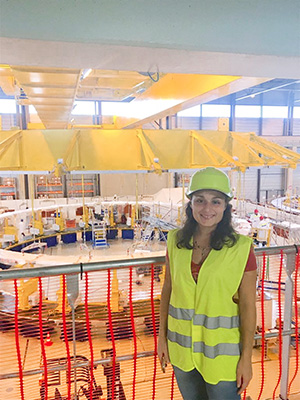Casali Named ITER Scientist Fellow for Fusion Research

Assistant Professor Livia Casali is a well-known figure inside the world of nuclear fusion, having spent several years with General Atomics, where she worked on DIII-D, the largest magnetic fusion device in the US, commonly known as a tokamak, and where she still leads the core-edge research area.
Prior to her employment with General Atomics, Casali spent several years at the Max Planck Institute for Plasma Physics in Germany working on another world’s leading tokamak known as ASDEX Upgrade on both experiments and state-of-the-art computational modeling.
Now, she’s also being closely aligned with the largest tokamak in the world, the International Thermonuclear Experimental Reactor, more commonly known as ITER, as the ITER Organization recently named her an ITER Scientist Fellow.
“I’m very honored for such important recognition, and I’m happy that it has given our college attention in the international fusion community,” said Casali, who is the Zinkle Faculty Fellow in the Department of Nuclear Engineering. “I’m very excited about this and the possibilities it creates.”
Casali came to UT in August of 2021 in part because it gave her a chance to build up coursework related to core-edge integration, which centers around the need to have the core hot enough to produce plasma, but keeping the edge cool enough that it doesn’t degrade the fusion chamber itself. It is considered to be one of the biggest challenges to making unlocking the promise of fusion.
Joining the department also gave Casali a chance to train the fusion engineers of tomorrow, something that is important to her and to the field in general.
“I was excited about the opportunity to create new courses on plasma physics and nuclear fusion, as I’m very passionate about sharing my interest for nuclear fusion and physics with students and the general public,” she said. “I’m enthusiastic about training new generation, and I hope through my example to be able to empower and inspire students, to be able to help them in shaping their future, and to realize their dreams.”
ITER was designed to help researchers test ideas related to fusion production, in turn paving the way for future reactors. ITER is the largest scientific project ever built.
ITER Fellows are drawn from the leading researchers in the members’ fusion communities who have achieved international recognition for their contributions to fusion research. In addition to such an important recognition, one of the many positives of her selection is that it provides opportunities for her graduate students to spend time at ITER and the scientists it draws from around the world, boosting their experiences as well as the reputation of the department, college, and university.
“They will benefit from close ties to the ITER team and access to a world class scientific and technological environment,” said Casali. “Through this, the students will play an instrumental role in shaping the ITER program and the future of tokamak fusion energy plants.”
Located in France, ITER is sponsored by the US, the European Union, China, Russia, Japan, India, and South Korea, with several other countries sponsoring portions of the project.
The ITER Scientist Fellows program began in 2016. The ITER Scientist Fellow Program brings together world-renowned experts from different laboratories around areas of specific development for ITER. Fellows play an important role in creating bridges with the fusion research with the united goal of making fusion power not only feasible from a scientific standpoint, but economically, as well.
In addition to working together on ITER, researchers will take the knowledge gained there back to the scientific communities from which they came.